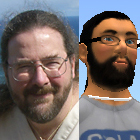Back to Digital Preservation Pioneers
 Early one recent evening, eight-year-old Colleen A. eagerly climbed onto the desk chair at the family computer, grabbed the mouse and settled in. It was time for her to visit her favorite kid-friendly online world.
Early one recent evening, eight-year-old Colleen A. eagerly climbed onto the desk chair at the family computer, grabbed the mouse and settled in. It was time for her to visit her favorite kid-friendly online world.
After logging on, she selected an animated cat named Princess as her avatar (a digital representation of her) and within minutes she found some avatar friends and they dashed off together into the vast virtual world to play.
Millions of people immerse themselves daily in games and virtual worlds and gaming is fixed in our culture. But only recently have cultural institutions begun attempts to document and preserve games. It is a thorny problem, even for those with substantial experience archiving other varieties of digital content.
Jerry McDonough, Assistant Professor in the Graduate School of Library and Information Science at the University of Illinois at Urbana-Champaign, is one of the NDIIPP-funded Preserving Virtual Worlds (external link) scholars working on the challenge.
He currently teaches courses in digital libraries, digital preservation and metadata design at UIUC. Previously he worked at New York University as manager of the Digital Library Development Team where he worked with the NDIIPP Preserving Public Television project team. As part of that project he helped establish best practices for archiving digital video and creating and maintaining a large-scale digital video archive.
While at NYU, McDonough helped launch the Metadata Encoding and Transmission Standard, an XML-based standard for encoding descriptive, administrative, and structural metadata regarding objects within a digital library. In 2002, he served as the first chair of the METS editorial board and was instrumental in building a user community for the standard.
Preserving virtual worlds and games involves several elements, including software, media (sounds and images), metadata and sometimes hardware. Since most games are commercial products, intellectual property rights are another preservation factor; McDonough is an advocate of working closely with game publishers as preservation allies.
Maintaining the authenticity of the game-play experience for the user is an elusive goal. Using "good enough" preservation methods might satisfy researchers who want a general idea about a game but those methods do not satisfy devoted gamers who can tell in a second whether the game experience is even slightly off. "People who've worked with emulating older games, players sensitive to minor changes – the speed of the game, aspect ratio of display – they pick up on the minutest details," said McDonough.
Vintage game enthusiasts are similar to classic car enthusiasts in their loyalty and emotional attachment to – and discriminatory tastes in – specific artifacts. For example, though cars today are faster, safer, more responsive and more fuel efficient, a classic car buff may have a strong attachment to, say, a '59 Cadillac. Similarly, even though games and machines today are more powerful, rich and responsive, a vintage gamer might prefer the original experience under the purest possible conditions. One gamer said she preferred to play the 1993 version of Doom, which requires a 1993 PC with a 386 CPU running DOS. Aficionado groups and cottage industries have sprung up around vintage games, creating not only a market for recycled computer parts but also spawning a small but dedicated software and hardware preservation movement.
But what about virtual worlds, where hundreds of thousands of users interact not only with the game but also with each other? How do you preserve that experience?
"It's really not technologically possible or socially possible to document everything in a virtual world," said McDonough. "It's like trying to preserve California and everything that people in the state are doing." The best that can be done is to preserve some contextual aspects, such as the software and some specific game states—snapshots taken at particular times
While it is impossible to capture the full community experience, one approach is to record the behaviors that develop around the games. "In virtual worlds, (these behaviors) might be role playing or contextual interactions, such as reskinning an elf character," said McDonough. "When we talk about preserving these worlds we have to approach that problem like sociologists and anthropologists having to go in and document a culture."
Video is one of the best ways to chronicle interactions, and members of the game-playing community have been active in recording their own gaming sessions. This helps capture the players' roles, interactions, jargon and etiquette. Henry Lowood, Curator for Stanford University Libraries' History of Science & Technology Collections and also a member of the Preserving Virtual Worlds project, was instrumental in getting the Internet Archive to create an area on their site devoted to game-play videos (external link) and archiving virtual worlds (external link).
Enlisting help from the community that you are serving is a solution that works well. Who better to document group behaviors than the group members themselves? "It's participatory ethnography," said McDonough.
McDonough outlined three outcomes he would like for the project. First, he aims to identify problems that may arise from archiving computer games; the problems will not be the same for each class of game. Second, he wants to identify technical, organizational, social and legal preservation strategies. His third goal is to preserve game content at UIUC and Stanford.
As with other NDIIPP projects, collaboration is one of surest methods of successful digital preservation. McDonough calls for re-thinking relations between users, content producers and archivists. He identifies a number of questions that need to be addressed. "Who's responsible for what? How do we collaborate? And who has resources for what?"
It is a multiplayer challenge.
